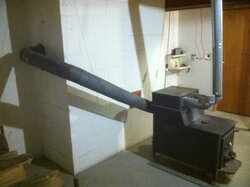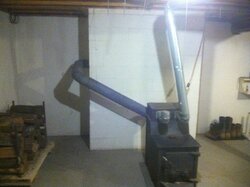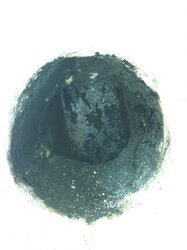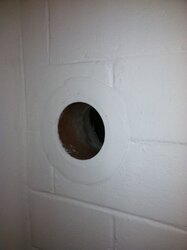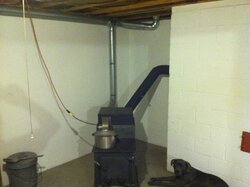Hi all,
Last December we purchased our first house. In the basement sat an Alaska Kodiak wood stove for supplemental heat. I had never burned wood before, but was very excited to learn about it. I've been on these forums since - learning so much its unbelievable. I've been working like mad to get 3 years ahead on wood, along with trying to make stove improvements. Just to give you some background information - It is a 79 Alaska Kodiak stove, with an inner baffle. 6 inch outlet out the back. My chimney is masonry, centrally located in the house. It has a 6 3/4" x 6 3/4" square terracotta pipe for the wood stove and a 6 3/4" x 11" for the fireplace (main floor) The height of the chimney from the basement is approx 21 feet, and from the fireplace, 12 feet.
My first year of burning was a quick learning one. That year I bought wood, which is the typical story, not seasoned nearly enough. I struggled to keep fires but learned alot in the process. So I made up my mind, this winter, I was going to be ready. I have wood that has been split/stacked for a year now. Most of it was deadfall when I had processed it. Walnut,Maple,Cherry, and some Ash. I have a Harbor Freight moisture meter, and most of the wood is 20% or less. It all burns so nice compared to last years wood - that was hissing and bubbling water.
The stove setup the original owner had was not very efficient. There was 3 90 degree elbows before it had to go up the chimney. So I decided to change that to get a better draft. My result was 2 45s before hitting the chimney. See pictures of before and after. Also the stove pipe going into the chimney was a mess. A 6"x8" fitting into an ugly hole in the block. I fixed this by cementing a piece of 8" terracotta flue pipe into the block. Also I got the "soot eater" chimney sweep and made sure the chimney was nice and clean to start the new burning season. They also had a "heat box" on the top of the stove with a blower, and a 4 inch duct going upstairs to an outlet in the hallway. I "improved" this setup by running new ductwork to a floor vent in our living room and bedroom. This helped heat the house considerably. The heat has a hard time making it upstairs without the duct system. The basement is all concrete and soaks up the heat like a giant sponge.
So now it is December, I have been burning since October - ish. Lets say about 3 months. I burn about 12 hours at night every night and 24/7 on the weekends. The new setup seems to work pretty great. I still have short burn times with the longest being around 6 hours. I just caulk that up to "oh well what can I expect,its an old fire dragon". I tend to burn pretty hot, stove top around 600F. I have gone through about 2 1/2 cord of wood so far.
I decided to clean the chimney today to see how I'm making out and was less than thrilled. About 2 gallons of fluffy creosote came out of that chimney. I am thinking that the air temp is not hot enough going up the chimney and creates alot of creosote towards the top. So my ultimate question in this huge novel I've written is - Do I install a stainless steel liner, to try and keep temps up to reduce creosote? Or Do I abandon the old fire dragon and purchase an insert for the fire place? Any advice would be greatly appreciated!!
Last December we purchased our first house. In the basement sat an Alaska Kodiak wood stove for supplemental heat. I had never burned wood before, but was very excited to learn about it. I've been on these forums since - learning so much its unbelievable. I've been working like mad to get 3 years ahead on wood, along with trying to make stove improvements. Just to give you some background information - It is a 79 Alaska Kodiak stove, with an inner baffle. 6 inch outlet out the back. My chimney is masonry, centrally located in the house. It has a 6 3/4" x 6 3/4" square terracotta pipe for the wood stove and a 6 3/4" x 11" for the fireplace (main floor) The height of the chimney from the basement is approx 21 feet, and from the fireplace, 12 feet.
My first year of burning was a quick learning one. That year I bought wood, which is the typical story, not seasoned nearly enough. I struggled to keep fires but learned alot in the process. So I made up my mind, this winter, I was going to be ready. I have wood that has been split/stacked for a year now. Most of it was deadfall when I had processed it. Walnut,Maple,Cherry, and some Ash. I have a Harbor Freight moisture meter, and most of the wood is 20% or less. It all burns so nice compared to last years wood - that was hissing and bubbling water.
The stove setup the original owner had was not very efficient. There was 3 90 degree elbows before it had to go up the chimney. So I decided to change that to get a better draft. My result was 2 45s before hitting the chimney. See pictures of before and after. Also the stove pipe going into the chimney was a mess. A 6"x8" fitting into an ugly hole in the block. I fixed this by cementing a piece of 8" terracotta flue pipe into the block. Also I got the "soot eater" chimney sweep and made sure the chimney was nice and clean to start the new burning season. They also had a "heat box" on the top of the stove with a blower, and a 4 inch duct going upstairs to an outlet in the hallway. I "improved" this setup by running new ductwork to a floor vent in our living room and bedroom. This helped heat the house considerably. The heat has a hard time making it upstairs without the duct system. The basement is all concrete and soaks up the heat like a giant sponge.
So now it is December, I have been burning since October - ish. Lets say about 3 months. I burn about 12 hours at night every night and 24/7 on the weekends. The new setup seems to work pretty great. I still have short burn times with the longest being around 6 hours. I just caulk that up to "oh well what can I expect,its an old fire dragon". I tend to burn pretty hot, stove top around 600F. I have gone through about 2 1/2 cord of wood so far.
I decided to clean the chimney today to see how I'm making out and was less than thrilled. About 2 gallons of fluffy creosote came out of that chimney. I am thinking that the air temp is not hot enough going up the chimney and creates alot of creosote towards the top. So my ultimate question in this huge novel I've written is - Do I install a stainless steel liner, to try and keep temps up to reduce creosote? Or Do I abandon the old fire dragon and purchase an insert for the fire place? Any advice would be greatly appreciated!!


